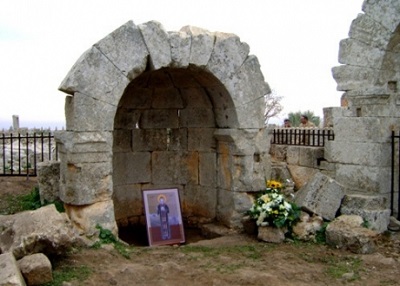Mar Maron lived in a period full of religious and political events which accompanied the spread of Christianity . Christian monks were highly influenced by the successive and concurrent events especially after Roman Emperor Constantine had issued the famous decree of Milan 313AD which allowed Christians to declare their new religion publicly and recognized Christianity as a state religion.
In his book “History of Maronites”, issued in the eighties of the past century, Lebanese father BotrosDhaw said: “Since the start of Christian era and until 313AD, Christians suffered from persecution. One day, exactly at sunset, Constantine, saw the image of a cross drawn in the sky by sun rays and “With this you will win” written near it. In the morning he ordered new banners be made for the army with the sign of the cross on them and he won the battle over his opponent, Emperor Maxentius, in 312AD near Rome. After that he ruled all Europe and issued the declaration of 313AD stopping persecution but short of declaring Christianity as a state religion.
The declaration assured freedom of religion for both Christians and pagans. In 330AD Constantine left Rome and lived in Byzantium, Istanbul today, and made of it capital of his empire.
In the period following the death of Constantine, Christianity spread in all Syrian cities while some rural areas remained on their paganism. At that time Mar Maron was born. During Emperor Theodosius reign, and exactly in 380AD, Mar Maron’s fame was at its utmost in Koresh, north of Syria, and exactly in the village of KafrNabbo. In this place, people used to worship an Assyrian God known as Nabbo, which was famous in Mesopotamia and in Syria. Mar Maron succeeded in convincing people to embrace Christianity and changed Nabbo,s temple into a church and abolished all traces of paganism.
In his book “History of the Church”, issued in 453 AD, Greek historian Theodoratos said:” Maron was not satisfied by promoting the new religion, but also dealt with the people of Koresh gently. He used to listen to their problems, to offer them advices, and to teach them the true teachings of Christianity. Many of them started believing in his power of healing diseases and sicknesses He did not pray for healing physical illnesses only, but also to cure the souls of people from other illnesses like hatred, selfishness, fanaticism and intolerance, calling for virtue and righteousness.
This policy of fighting paganism and good behavior convinced many priests and hermits to seek his teachings in KafrNabbo. Among them was the famous St. Simeon the Stylite who spent 37 years of his life worshipping God on a pillar.
 In his book “History of Times” Lebanese historian EstephanalDwehi (1630-1704) said: “Originally, Maronites are an Arab tribe which came from Najran, in Yemen, after the devastation caused by the failure of Ma’areb Dam and settled in Northern Syria. At the beginning of the fifth century people of this tribe followed Mar Maron. When Maron’s fame spread in the region many monks and priests followed his steps and started building churches and monasteries in the region”.
In his book “History of Times” Lebanese historian EstephanalDwehi (1630-1704) said: “Originally, Maronites are an Arab tribe which came from Najran, in Yemen, after the devastation caused by the failure of Ma’areb Dam and settled in Northern Syria. At the beginning of the fifth century people of this tribe followed Mar Maron. When Maron’s fame spread in the region many monks and priests followed his steps and started building churches and monasteries in the region”.
As a result, the term Maronite, a religiousname, was given to the Arab tribewhich followed Mar Maron in the middleof the fifth century. At that timeChristians were divided into Arians,after Arius, Priest of Alexandria, whobelieved that Jesus Christ is a humanbeing, Monophysites, and Nestoriansafter Monk Nestorius, Patriarch ofConstantinople who insisted on thedivine nature of Christ. Each partybelieved they were right and foughteach other about their different doctrines.Mar Maron, and his followers,refused to follow either of them and continuedbelieving in the Nicen creed, promotedby Emperor Constantine whobelieved that Christ has two natures;human and divine.
Mar Maron used Syriac, language ofJesus Christ, in his prayers and sermons,and it is universally known that theword “Mar” in Syriac means Master.
Maron died in 410 AD in KafrNabbo butwas buried in Brad, only a few kilometersfar from KafrNabbo, which was thecapital of Koresh. Ruins there indicatethat Brad was a large city at that time,and it is also said that Maron’s followersestablished the Monastery of Simeon thePillarist (Stylite) in 454, i.e. after 44 yearsof Mar Maron’s death.
After his death the Maronites entered ina struggle with the Jacobeans(Followers of Monk Jacob who insistedon the Calcedonian doctrine and heldthe Council of QadeKoy in Turkey, nowon the Bosphorus) in 451AD to confirmthe decisions of the Council of Nicia.When some Maronites embraced thedecisions of Nicia’s Council they raisedmany problems with the Jacobeans andlost more than 350 Martyrs killed by theJacobeans. This event forced many ofthem to migrate from Northern Syria toLebanon’s mountains in the second century,and this was their first movementof migration to Lebanon.
The visit of many important LebaneseMaronite personalities to the tomb ofMar Maron were important occasions tostart annual convoys of ChristianMaronite pilgrimage to celebrate thesacred anniversary of the death of MarMaron .
Haifaa Mafalani

